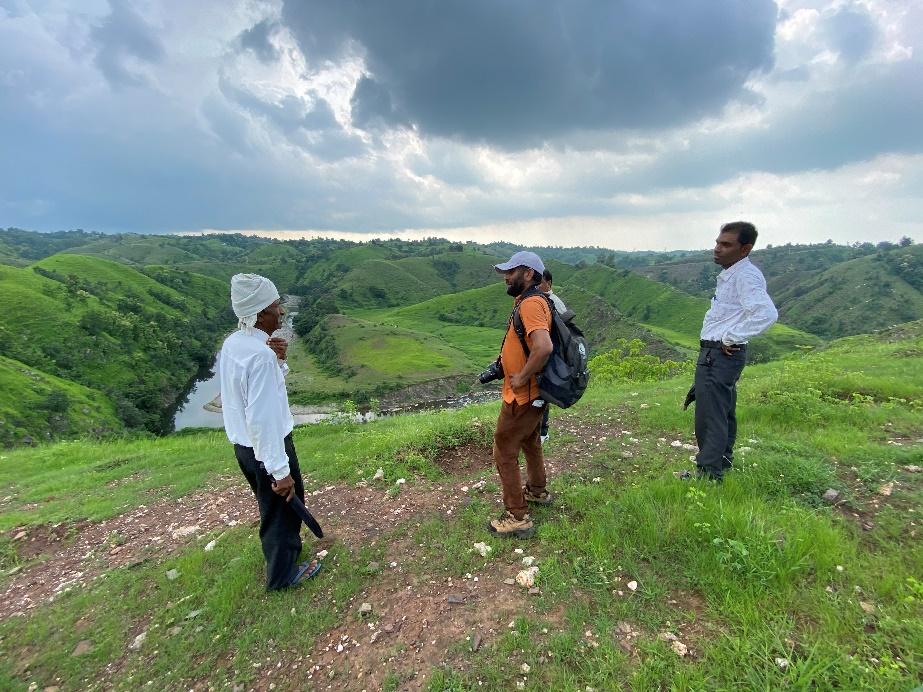Above: Visiting the charaaga with Dr. G.P.S. Jhala (centre) and Shri Arjun Singh (left), accompanied by Mr. Ashok Meena (right), also of Seva Mandir. (Photo by K.S. Gopi Sundar)
The Effects of Abnormal Weather Patterns
In 2022 southern Rajasthan experienced above average rainfall, imparting significant local impact. In a vivid first-person account, K. S. Gopi Sundar, research scientist at Seva Mandir, recounts a trip to see a charaaga (community grassland), reflecting on the importance of listening to and working in partnership with village communities to create and preserve these essential common lands.
When the Global Overwhelms the Local: of Democracy, Plantations, and Irregular Weather Patterns
By K. S. Gopi Sundar, Scientist, Seva Mandir ([email protected])
The Local: Creating and Maintaining Charaagas
We crossed the rough boundary wall made of stones piled atop each other into a charaaga (or grassland) that overlooked a stunning valley. Beyond the valley, the Aravalli hills extended seemingly endlessly, and the dark foreboding clouds promised rains that the scorched earth needed badly. I was with Dr. G.P.S. Jhala, one of the people who constituted the small army of forestry and plantation experts of Seva Mandir.
He was accompanied by the institution’s team members and Shri Arjun Singh, the person who had led the years-long effort to free the stunning community grasslands from an illegal squatter. After many long months of discussion, persuasion, and passionate requests, the squatter agreed to take up the neighbouring hillock for his farming needs. The village got together in the spirit of true seva (or service) and built a rock wall around the newly freed charaaga.
The dark line of loosely piled rock on the otherwise green hillside signified an unthinkable victory. A village had worked democratically to peacefully secure a critical common resource, grasses and trees, that in turn meant assured food for livestock of a few households.
Freeing the charaaga was but the first laborious step. Dr. Jhala told me that the grassland’s gently sloping and steep slopes were both greatly degraded with overuse. Grasslands can be notoriously fussy, he noted, and need annual holidays from grazing livestock. Give them just a season or two and some spells of good rains and the swaying, lush green stands filled with an astounding diversity of grass species would be back.
The sparse tree cover that accompanies these degraded grasslands was another matter. It would require careful engineering of small but temporary dykes made of local stone and mud. These would need to be spaced out and would help hold back the eroding slopes, retain some extra moisture, and give a new sapling a fighting chance at survival.
Seva Mandir’s Natural Resources Department, of which Dr. Jhala was part of, had worked for over three decades in over 1,300 villages helping create and develop over 16,000 hectares of charaagas in myriad conditions. The teams worked shoulder to shoulder with tens of thousands of villagers each year, adapting to novel conditions that each charaaga posed, learning local methods, spreading methods from one valley to the other, and experimenting with plantation methods.
Villagers worked with agroforestry experts of Seva Mandir to decide on the tree species that needed to be planted. Some villages had more goats and needed species whose branches could be harvested at regular intervals. Others had cows and buffaloes and evolved mutually agreed upon schedules and quotas of grass harvesting during the winter each year.
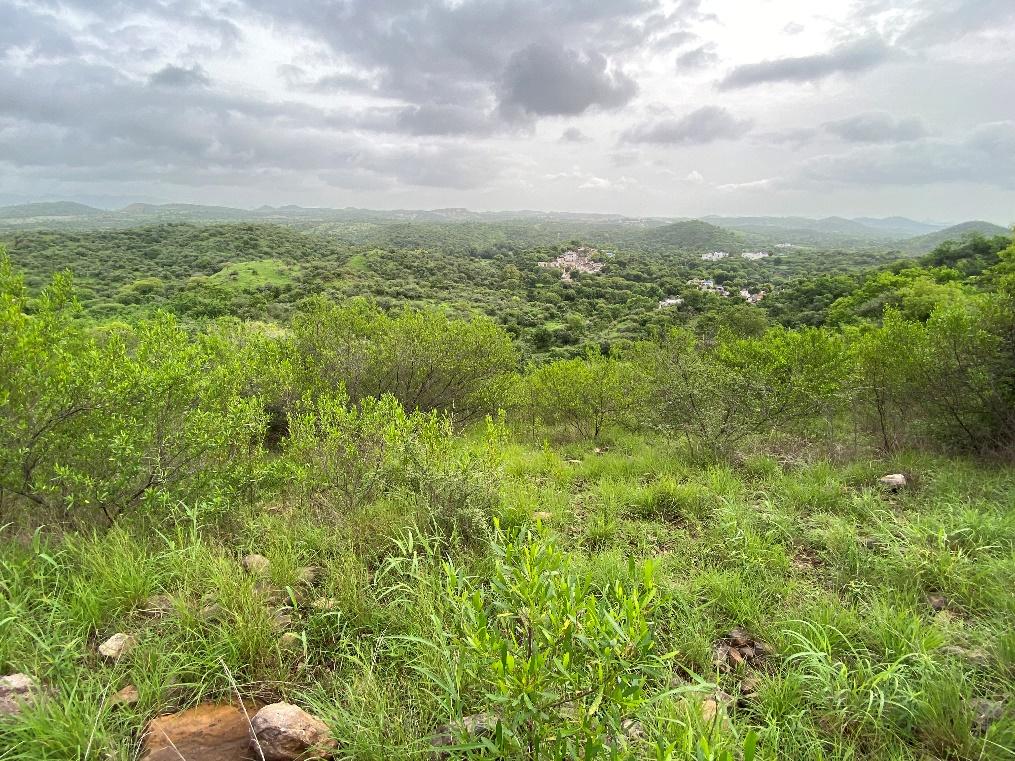
A view of one of the older charaagas, which Seva Mandir and local communities have preserved in Udaipur district. (Photo by K.S. Gopi Sundar)
Some villages used a traditional method, the sooiya, roughly translated to “of a needle or sooi” but with the meaning “stitched together”. The village selects a household to guard the charaaga for a predetermined time. The guarding household held on to a piece of wood or bamboo that was prominently displayed in the front of the house’s yard. When the period ended, the guarding family placed the wood in front of another household. The guard thus changed and the critical vigilance continued thanks to the collective sense of community.
Households in the entire village took the charge of guarding very seriously and helped to prevent the entry of cattle outside of grazing season, stop illegal wood cutting, and safeguard the rock wall. The eponymous sooiya moved through the community stitching them together into a deeply unspoken bond of responsibility, the centre of which was the common resources that the charaaga provided.
Slowly, but very surely, Seva Mandir and the host villages were reviving the Aravallis one charaaga at a time. What is more, the grasslands and scrub forests were being maintained at the choosing of the villages, who also took on great responsibility to protect them.
In the 2022 monsoon season, just as the terrible COVID-19 pandemic subsided, Seva Mandir and its host villages completed the monumental task of planting 350,000 saplings. By any standard, this was a record that everyone could be justifiably proud of.
The charaagas and the careful engineering of tiny but important rock-dykes would secure invaluable Aravalli ecosystems for the long-term while catering to the sustainable needs of thousands of families. The saplings that survived would slowly sequester carbon, not only reviving important wild resources but aiding the critical flight against global climate change. The soils would stay on the slopes, the goats and cows would have full bellies, and the guaranteed natural resources provided the otherwise impoverished villagers a great sense of security.
The Global: Indeterminable Heat and Floods
While Seva Mandir planned for their record-breaking restoration and conservation of grasslands and forests, 2022 started poorly in south Rajasthan. Following a mild winter, most of south Asia was hit by arguably the worst heat wave in living history. Temperatures reached seasonal maxima two to three months early and stayed high. The Aravallis simmered in a dry heat that sucked dry rivers, streams and reservoirs.
Some stories that Ms. Paridhi Jain, previously working with Mr. Arun Maheshwari in the Natural Resource Department at Seva Mandir, told me after visiting four remote villages in Jhadol tehsil beg retelling. Tindori, Sarwan, Dharawan and Lathooni villages were close to the Phulwari Wildlife Sanctuary. For centuries, villagers collected leaves, flowers, bark, and some sticks for household use, and with some luck, also got enough to barter or sell.
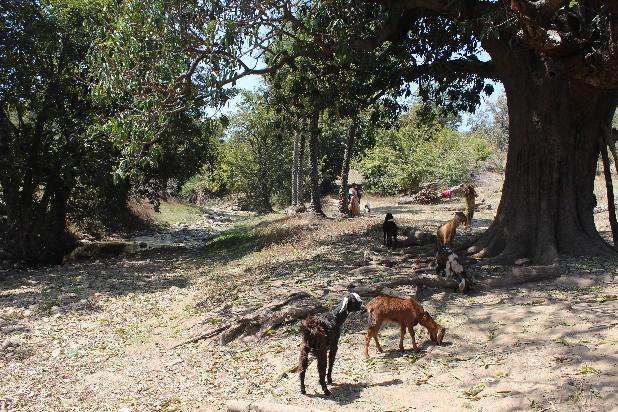
A view of one of the remote villages where Seva Mandir conducted a rapid assessment of impacts of climate change on tribal communities. (Photo by Paridhi Jain)
The forest produce provided food, and flowers for making local alcohol and medicines for both humans and livestock. Ms. Paridhi visited them in early 2022 to ask if the weird weather had had an impact on their forest resources.
What the villagers reported was appalling.
Trees were flowering earlier than before, making it difficult for them to schedule visits. Since heat waves had become much longer than ever before, flowers were withering away, and any fruits that formed were drying early. Driven to further stark poverty, many more people were cutting down trees to use or sell and accentuating the problem by reducing the number of trees whose resources could be sustainably harvested. Villagers were taking more and more time searching the forest but returning from their foraging trips carrying less and less produce.
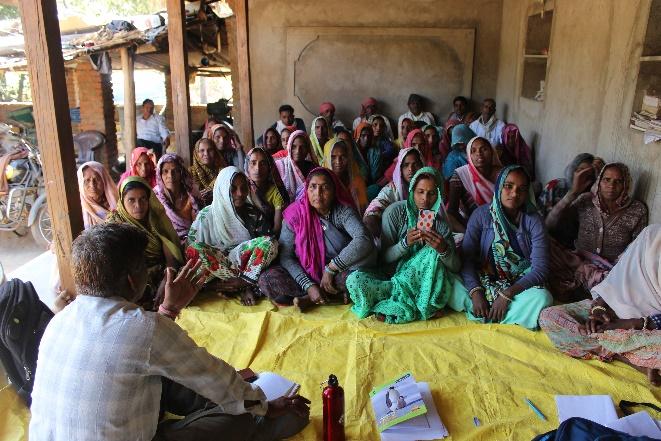
Village women participating in one of the participatory rural appraisal sessions, organised to understand local impacts of climate change. (Photo by Paridhi Jain)
The tragedy caused by the heat in 2022 was preceded by another weather anomaly. The late winter of 2022 saw nonseasonal and disastrous rains that wreaked havoc on most of the winter crops. The crops that withstood the rains and the floods were attacked by more insects than the villagers had seen before.
It was getting increasingly difficult to predict rainfall and how hot and long the summer would be. Many more villagers were making the long journey to the nearest town to eke out a living. Young people are seeing less of a future for themselves as farmers and are attracted to the cell phones and shiny bikes that the city dwellers roam on.
Enmeshing the Local with the Global: Innovations for the Way Forward
Today more than ever, long-term and staid interventions such as those being enacted by organisations like Seva Mandir are the urgent need. As the march of climate change is felt deeply among the poor communities across the Aravallis, so too should the act of the local be enhanced. It is not the time to feel despair, but the time to listen, think and act.
In 2022 southern Rajasthan has received way more than its annual average rainfall. This was a year that showed how global climate change can deal multiple blows to the region within a year. And these blows are not likely to be the same every year. So, we have begun talking to communities to understand how each weather incident impacted them, and especially to document any traditional method they used to reduce the negative impacts.
Some farmers broadcasted rice into maize fields that were flooded by unseasonal rains and were unlikely to yield a good crop. Rice, usually grown by transplanting, provided them with some sustenance instead of none. This traditional method of adding a crop when weather threatens the possibility of a failed primary crop, can help with ensuring food despite conditions changing drastically within a season.
Others took advantage of the high rainfall and, with Seva Mandir’s help, experimented with harvesting and commercially selling guava fruits. The guava trees were planted as part of an experiment of creating a dense plantation in a few farmers’ fields. They proved to be a lifesaver for these farmers in this super wet year. We have also continued to expand ongoing work, such as repairing traditional anicuts (or check-dams) to store water and reduce soil erosion.
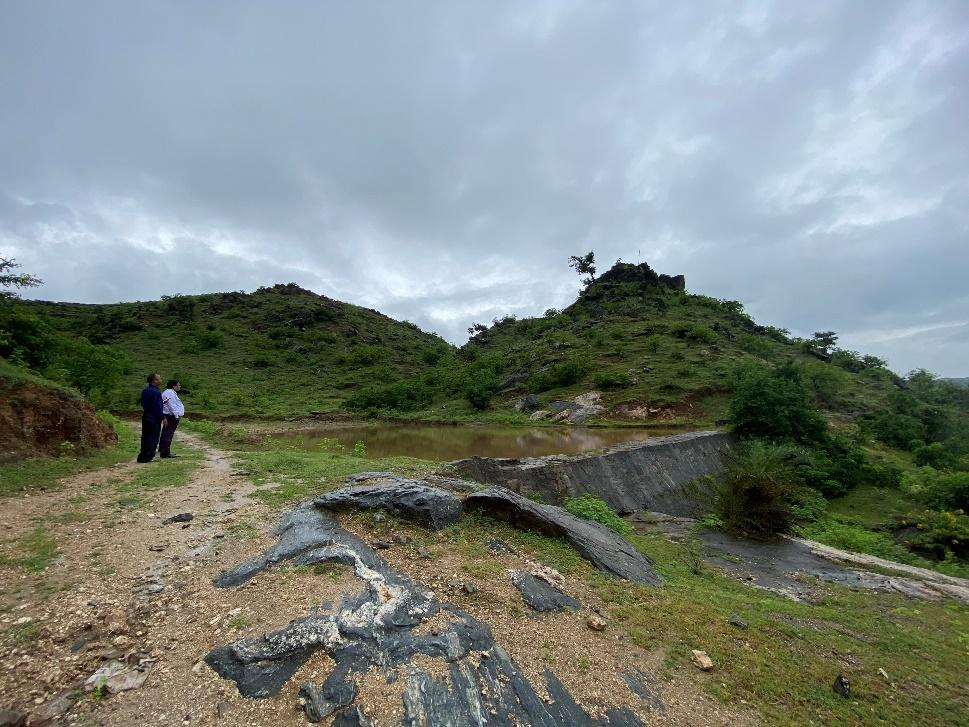
Mr. Arun Maheshwari (right) and Mr. Bhagirathi Singh of Seva Mandir inspect a recently repaired anicut that reduces soil erosion (especially during high rainfall periods) while increasing water availability (especially during dry months and years) for farming. (Photo by K. S. Gopi Sundar)
This particularly hard year brought home the importance of setting up multiple mechanisms where tree species are planted, based on local conditions. Spreading out the risk that a very small number of crop species could potentially have by increasing crop diversity was proving to be a buffer against impacts felt due to disagreeable and unpredictable weather patterns.
End Note
At Seva Mandir, as we learn more, we are realising the immense value of continuing to listen to village communities. We are witnessing astonishing resilience at locations where villagers coalesced into functional democratic communities. We are also learning that we may not have secured enough charaagas.
We are reading work from around the globe and discovering that planting more tree species may increase resilience. We are understanding that grasslands and savannas are way more efficient at sequestering carbon than poorly planned dense forests. These learnings are making their way into our emerging plans that seek to take on an uncertain future.
And the show, as they say, will go on.
Afforestation Programme
Background
Rajasthan’s biodiversity has a unique and significant value in the ecology of semi-arid regions located in its southern region. The Aravalli terrain of southern Rajasthan is a biodiversity-rich area, which accommodates a variety of wild flora and fauna. However, the habitat of these varied species is threatened by, and often lost to, climatic stressors such as droughts (southern Rajasthan is a drought-prone area) as well as other ecological factors. These factors have a pronounced negative impact on people’s livelihood sources, such as land, forest and water.
Across Seva Mandir’s working area (Udaipur and Rajsamand district), 95% of the population is dependent upon common land, including pastures and community forest resources, for their livelihood. These lands have immense value, economically and socially, among local people. For this reason, they are often highly contested by different groups and individuals in the community. As a result, these valuable natural resources are often exploited for immediate gain without consideration of the long-term benefits. Poor land governance has led to illegal encroachment and dilapidation of common lands. A wide range of factors that include low rainfall, irregular monsoons, increased climatic variability (eg. extreme fluctuating temperature), unregulated grazing of livestock and the unpredictable attack of pests and diseases frequently threaten the survival of vegetative cover. The rejuvenation of these eco-habitats is of paramount importance.
The conservation of precious local biodiversity is intimately linked to traditional knowledge systems. Seva Mandir has been working for three decades on a community-based approach to managing common lands, centred on the principles of inclusiveness, participation and transparency.
Seva Mandir’s Response: Afforestation Programme
A wasteland development programme was initiated in 1986 by the Government of India with the aim of reversing the widespread environmental degradation. It began by encouraging individual farm households to plant native tree species on their non-cultivable lands. Soon, the development of pooled individual wasteland and common panchayat land (common pastureland) began adding up. Community pastureland development work helps to integrate ecological restoration and people’s livelihoods in a sustainable way.
Afforestation has been a core component of Seva Mandir`s efforts of wasteland development since the mid-1980s. The work of planting trees is largely taken up by the local village institutions called Gram Vikas Committees. The planting of saplings is carried out alongside soil and moisture conservation activities to aid ecological restoration of degraded areas. In addition, a key area of Seva Mandir’s afforestation programme also supports capacity building around the development, protection and management of planted areas within partner communities. The programme has achieved many positive outcomes so far, with the notable achievements as outlined below:
- Over 16,500 hectares of wastelands have been green covered with plantations of 12 million saplings of native species.
- Over 300 community pastures and forest sites have been developed.
- Around 76,000 families have benefited from the programme so far, especially women who are primarily involved with non-timber forest products (mainly fuelwood and fodder collection).
- 37 forest sites have been developed under the Joint Forest Management programme and 17 sacred groves of 2047 hectares have been developed, directly benefiting 10,800 families.
- 10,600 hectares of private wasteland have been restored, benefitting 3260 families.
- 68% of the developed pastures and forest sites are now properly managed by the community.
To read more about Seva Mandir’s afforestation programme and its vital conservation efforts, please click here.
Waste Management
Small towns and peri-urban areas display features of both rural and urban communities, but with a higher population density than rural communities. Social relationships are based on the caste and kinship system, and there is generally more political tension between the different sections of the population than in rural areas. Peri-urban areas normally have their own panchayat (village-level elected local government body). These ‘in-between’ areas are not accorded urban civic status by the government but are still classed as rural villages, hence they are easily overlooked. As a result, they lack adequate services such as a proper water supply, sanitation, garbage collection and disposal, street cleaning and lighting. The majority of the workforce in these areas travels daily to the nearby city or further afar for labouring or semi-skilled work or is involved in semi-skilled occupations locally. Waste management is becoming a major challenge especially for rural towns and villages.
Seva Mandir has been working with one such peri-urban settlement, Delwara, for about 15 years. Taking learnings from there, Seva Mandir has recently begun work with another peri-urban area called Kelwara. The challenges faced by these two areas are different in many ways from those faced by the rural areas with which Seva Mandir does most of its work, requiring somewhat different solutions.
Kelwara is a popular tourist site 75 kilometres from Udaipur, close to the famous Kumbhalgarh fort. More than 1000 tourists visit Kelwara daily, passing through the main market area to reach the fort. As a result, many hotels and resorts have been set up on the tourist route, and large quantities of waste are generated by the hotels, shops and the public transport vehicles that stop in the town daily.
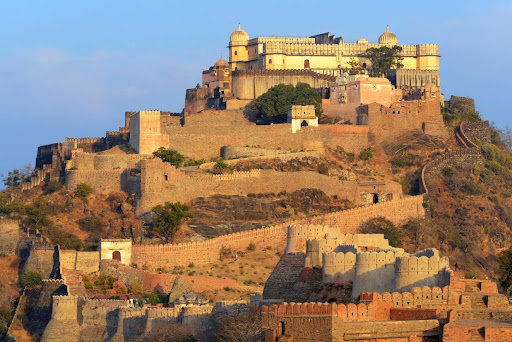
The famous Kumbhalgarh fort
Seva Mandir initiated a community-led waste management intervention in Kelwara in 2019, in partnership with Kelwara citizens, panchayat (village-level elected local government body), District Administration, aarogya mitras (waste collectors) and other stakeholders. The intervention was created with the aim of piloting a waste management model for small towns, promoting multi-stakeholder involvement in the waste management system and encouraging wider behavioural change around waste management. This intervention was achieved with the financial support of CSR: InterGlobe Foundation, with technical support from non-profit waste management organisation, Saahas.
Before the intervention started, Kelwara faced problems common to other small towns: scattered waste, irregularly cleaned streets and the dumping of mixed waste in open plots and streams. The drains were blocked with rubbish, which hampered the flow of stormwater when it rained. Street cleaning was done infrequently, so payment for cleaners did not happen often.
The project was initiated with a three kilometre patch of the main Kelwara town. The road comprises the main market, some homes, block administration offices, a bus stand and hotels. The Kelwara Vikas Samiti (Kelwara Development Committee) was formed with representatives from all stakeholders to support in planning and supervising the activities.
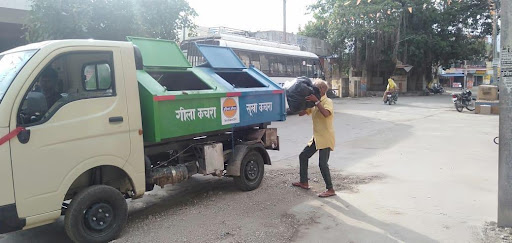
Vehicles travel from door to door to collect waste
As a result of the intervention, cleaners and Aarogya Mitras (waste collectors) became motivated and recognised in their work, and their issues with payments and tools were addressed.
The key activities that were undertaken in the initiative include:
- Daily cleaning and door-to-door waste collection via collection vehicles, as well as source segregation of waste (dry and wet separately).
- Building technical know-how and capacity building of aarogya mitras (waste collectors) mitras, samiti (committee) members and project staff.
- Multiple events and campaigns for generating awareness, which include door-to-door campaigns, wall paintings, distribution of posters, nukkad-nataks (drama and performance), drawing competitions in schools, road rallies and audio campaigns.
- Continued regular meetings with the community and local governance
- Repair and construction of new drainage systems
- Development of a resource recovery centre used for storing sorted dry waste, connecting with cement factories and kabadis (Scrap collectors/ buyers) for sales (revenue generation) and proper disposal of dry waste.
- Encouraging key waste generators (eg. hotels) to provide monthly fees for waste management services
- The dissemination of learnings via a district-level workshop
Kelwara market is much cleaner and far better managed now. On average, 450 kilograms of waste is being collected daily by the collection vehicle. This is a dramatic improvement as prior to the initiative, there was no organised waste collection system in place. To date, seven tons of recycled items have been sold to local kabadi walas (scrap collectors/ buyers). A total of INR 115,000 was generated from the sales and used for payment to aarogya mitras (waste collectors) and collection vehicle expenses. The revenue generated is able to fund 25% of the intervention’s total expenses, and Seva Mandir is currently trying to involve other hotels in the intervention to increase this revenue.
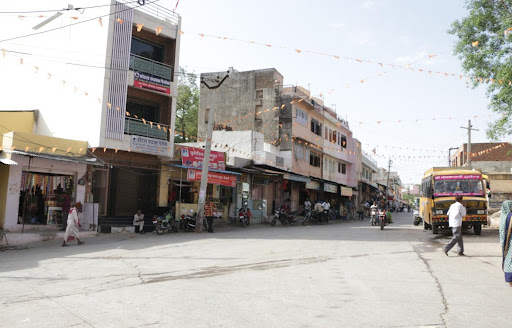
Clean main market area, Kelwara
Work in Kelwara has also started to inspire other peri-urban areas. On World Environmental Day this year, a cleanliness drive was organised by Seva Mandir in three other peri-urban locations: Jhadol, Gadhbor and Khamnor. The objective of the drive was to spread awareness about protecting the environment from various types of hazardous waste. A total of 500 people from the local community including household members, shopkeepers, gram panchayat (village-level elected local government body) members and Seva Mandir staff came together for shramdaan (voluntary labour work) for cleaning the peri-urban areas. There was high enthusiasm among everyone that participated, and the event concluded with meetings involving all stakeholders to discuss how to take greater responsibility for cleaning and maintenance of their regions.
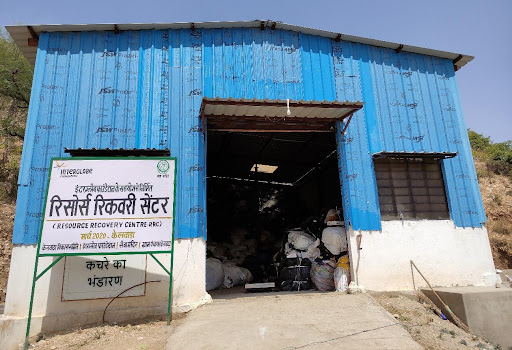
Developed Resource Recovery centre
Next Steps:
The waste management model has been highly appreciated by the State Government and has started being replicated throughout Rajasthan. This success is owed to the sense of ownership taken by the local community, as well as the involvement of stakeholders in the planning and implementation. However, building and strengthening this kind of ownership is difficult for the local government as there can be a tendency for people to place responsibility solely on the government without taking responsibility for their own waste. Hence there is a great need to carry forward the learnings from the Kelwara model and build the understanding of other stakeholders on how to replicate this in other peri-urban locations.
Recognising this need, in the next six months Seva Mandir aims to work on preparing and sharing a guiding document explaining the processes and methods of combating challenges involved in developing a waste management model of this kind. The guide can then also be shared with government functionaries and interested stakeholders in new areas, so that they may build their knowledge and skills in order to implement their own waste management projects under the Swachh Bharat (Clean India) Mission Phase II, a campaign initiated by the Indian Government to clean the streets, roads and infrastructure of the country.

